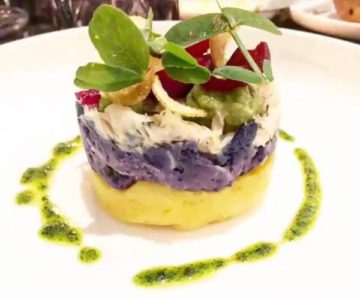
The first time I ever had a causa I was at the groundbreaking restaurant fellow future Mango Gang Chef Douglas Rodriguez opened. It was named Yuca for those who might not know. We were sitting upstairs and I was with a party of six or eight. Douglas was down in his kitchen creating some of the most exciting food to be had in the 305 back then. I was surprised by the very look of this menu item he’d sent to us. It was like a multicolored terrine shaped construction of various potatoes. He’d garnished it with seafood and what might have been the Peruvian corn known as choclo. More than my other fellow Mango Gangers Doug was able to source his creations directly from his Latin blood. Myself and the other two were transplanted Northerners. No shame in that. It’s simply true. But I was deep in the hunt even then for the kinds of dishes that would mark my menus as distinct from the menus of other chefs in the USA back then. One of the highest compliments I have ever received was when Spanish born Chef José Andres told an audience that he learned more about how to take Latin flavors ‘globally’ from me. José… as the world has come to know … has a gigantic heart. But he speaks from it. No B.S. from that Spanish gentleman. And another thing that speaks from the heart is the dish that became known as a causa… It has history!
This dish was born during the Pacific War in 1879 when Chile fought against Peru and Bolivia. The army of Peru had so much trouble getting food that women were collecting potatoes and other foods in all cities. So they created the meal they offered to soldiers “for the cause”. Hence “causa”! In 2003 I was finally finishing a book I’d been writing for close to three years. It is titled, “New World Kitchen”. In that book I took on a near impossible task and that was to try and give my best take on the cuisines of all of South America, Central America and the Caribbean. It was my relative youth I suppose that created the emotional if not intellectual armor of such a task! But… boy did I learn a lot in the process of studying, testing and writing that book. The country of Peru alone has been the topic for large cookbooks. Some have compared the complexity of Peruvian food with that of France. We tend to grossly simplify our viewpoints on what any country’s food is about. It is more often ceviches and their cousins folks tend to quickly stereotype Peruvian cuisine around. But Peru offers no less than 7 potato species and more than 5,000 varieties of all shapes and colors.
As we return to the thoughts of those women that created potato dishes for the troops it is natural that they would want to foster a special kind of pride in the presentations they served. So this is not a lump of mashed potatoes folks. It is more typically an artfully arranged layering of potatoes along with other ingredients that make for a colorful dish. While some might find their creative outlet in making patchwork quilts or stained glass the women of Peru were making soldiers happy with the humble potato. The battle was won.
I’m Norman Van Aken and that’s…. My Word on Food
Recipe
Peruvian Causa With Potato, Crabmeat And Avocado
Norman Van Aken, © 2001
Yield: 6 Cups, (Serves 6-8)
- ¾ pound new potatoes, scrubbed
- 1 ½ teaspoon Creole mustard
- 2 Tablespoons lemon juice
- 1 Tablespoon + 2 teaspoons Spanish sherry vinegar
- 1 Tablespoon extra virgin olive oil
- 1 ½ teaspoon Tabasco
- 2 Tablespoons minced chives
- ½ teaspoon minced thyme leaves
- 1 Cup corn kernels, blanched in boiling water for 1 minute
- ½ Cup inner spears of celery, rinsed and finely chopped
- 1 Cup crabmeat, cleaned
- ¼ Cup pitted Niçoise or Arbequine olives, chopped
- 1 perfectly ripe Haas avocado, diced
- Kosher salt and cracked black pepper, to taste
- 1 tomato, skinned, seeded and chopped
Place the potatoes in a pot and cover with water. Bring to a simmer over medium heat and cook until the potatoes are just tender when pierced with a knife, about 30 minutes, (depending on the size of the potatoes). Drain them from the water and chill, (they will slice better this way.)
Whisk the mustard, lemon juice, vinegar, oil, Tabasco and herbs together in a bowl.
Peel and discard the potato skins. Dice them into ¼ inch cubes. Now combine them with the corn, celery and crabmeat. Toss with the dressing.
Fold in the avocado and tomato very gently. Top with the chopped olives.
Serving Suggestion: Put the mixture on a large platter with a variety of potato and or corn chips surrounding it. If you’d like to serve this individually you could nestle the salad inside of some lettuce leaves.